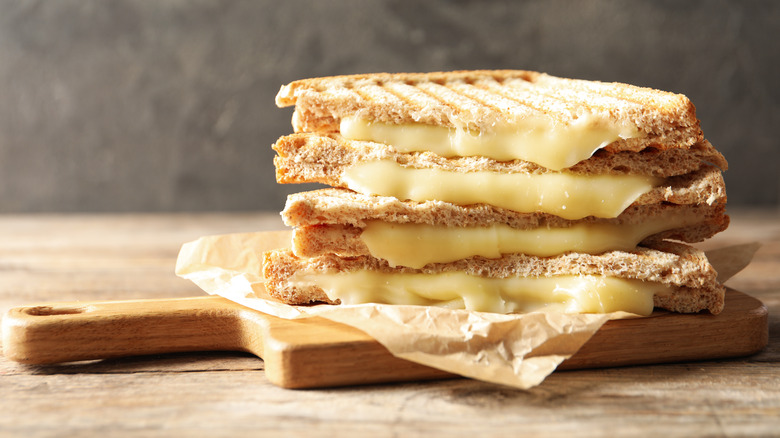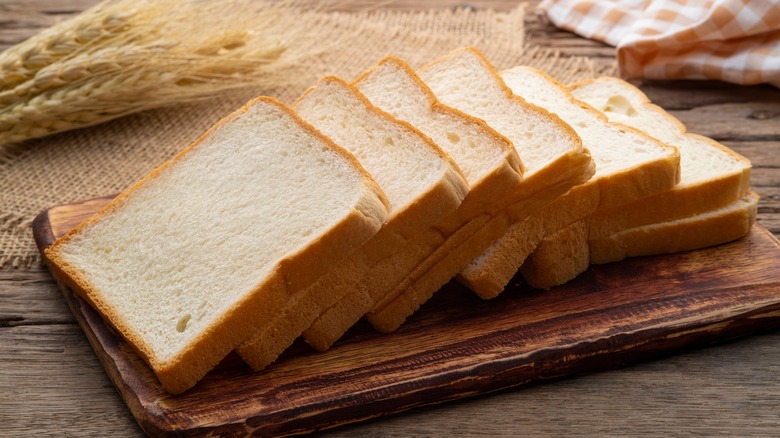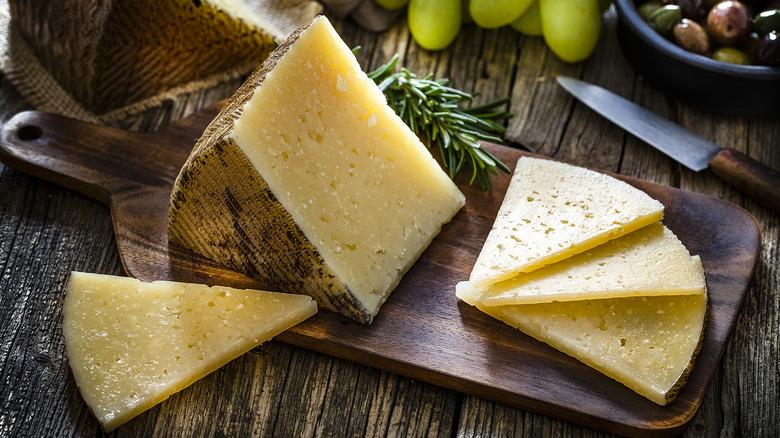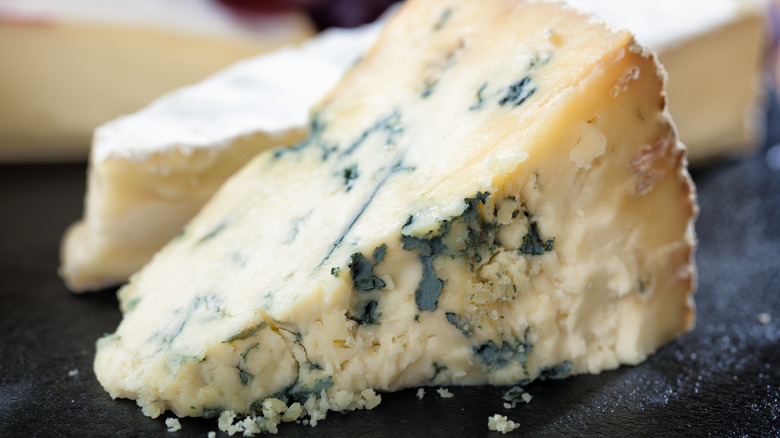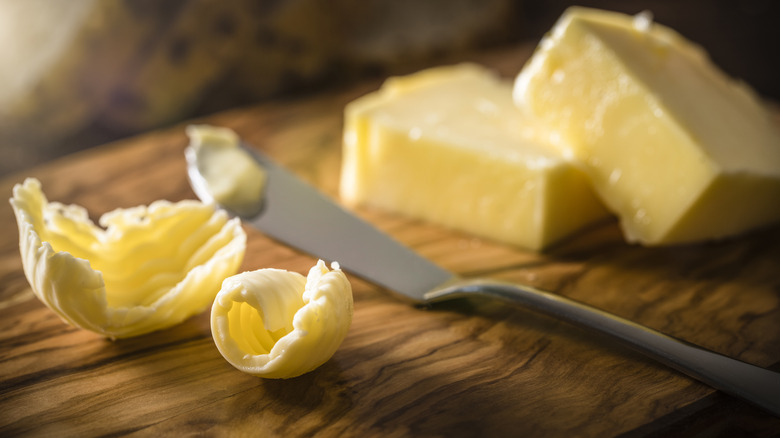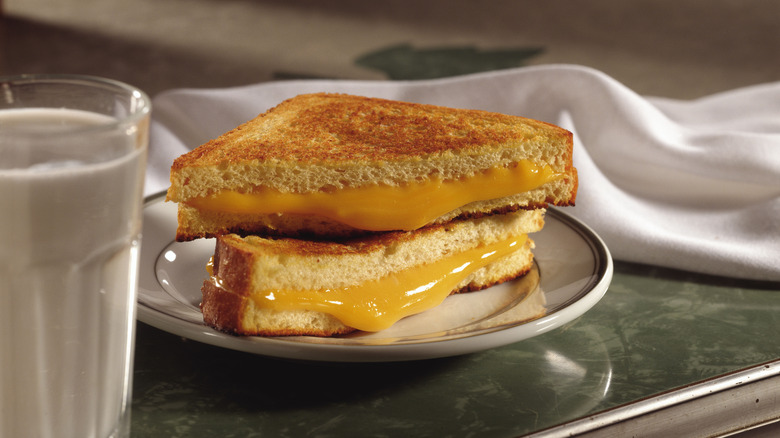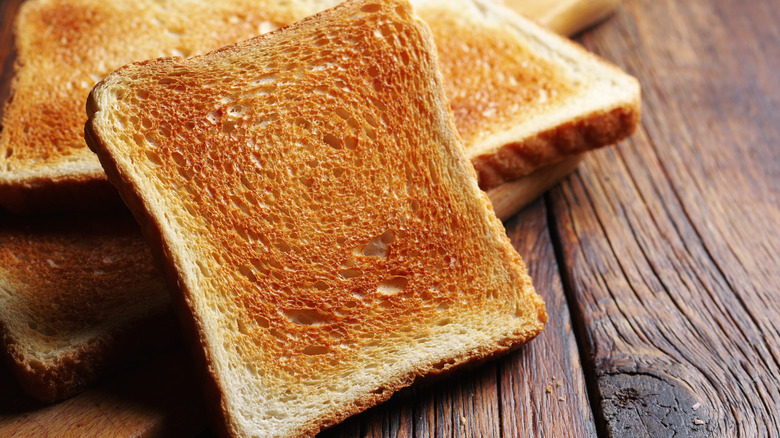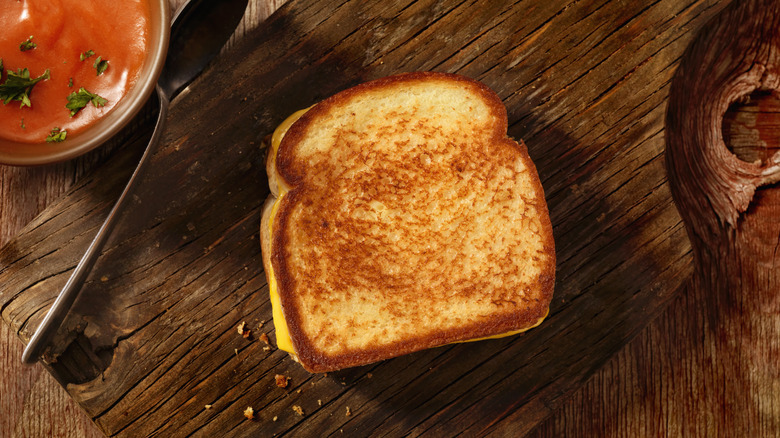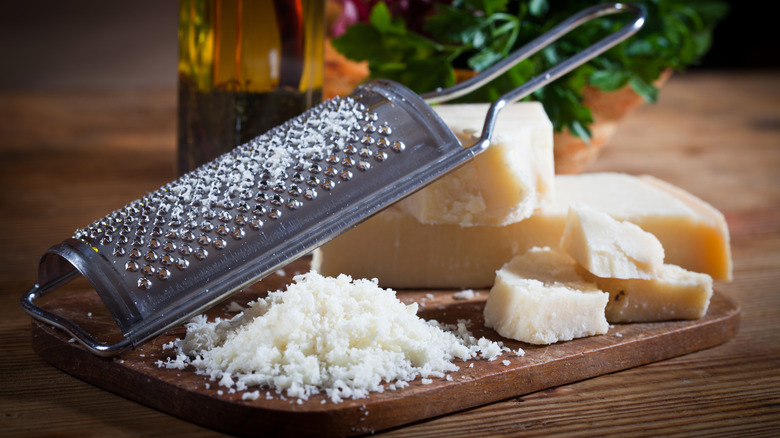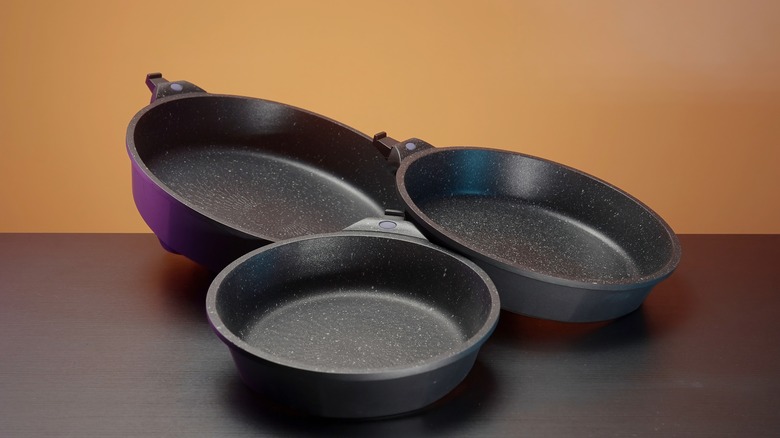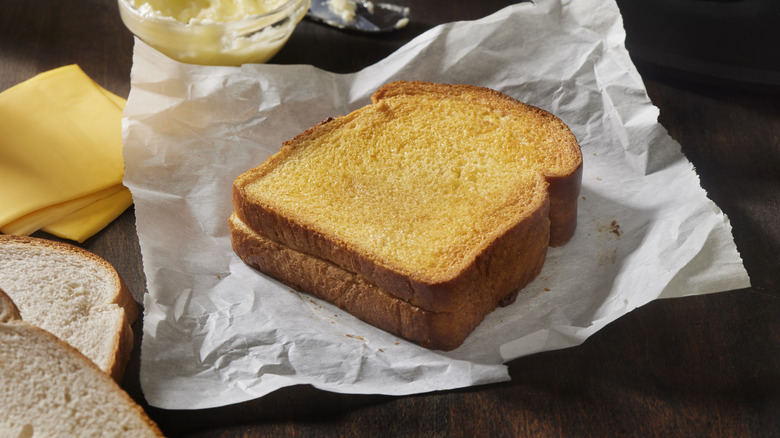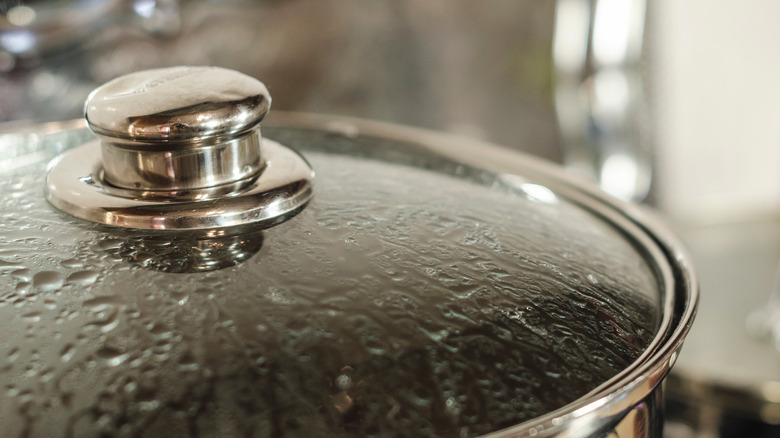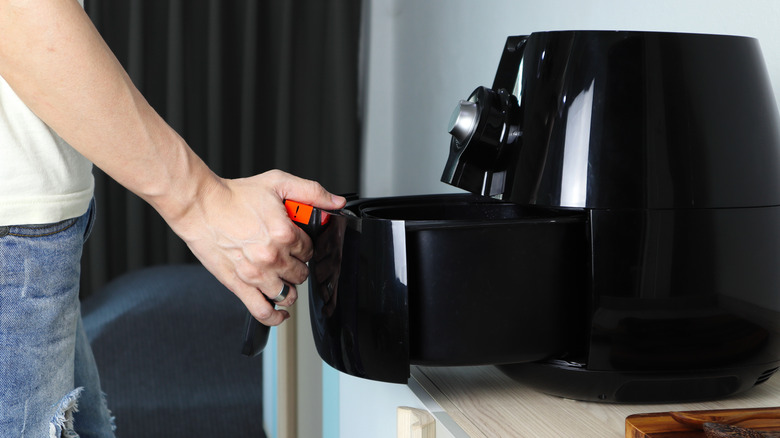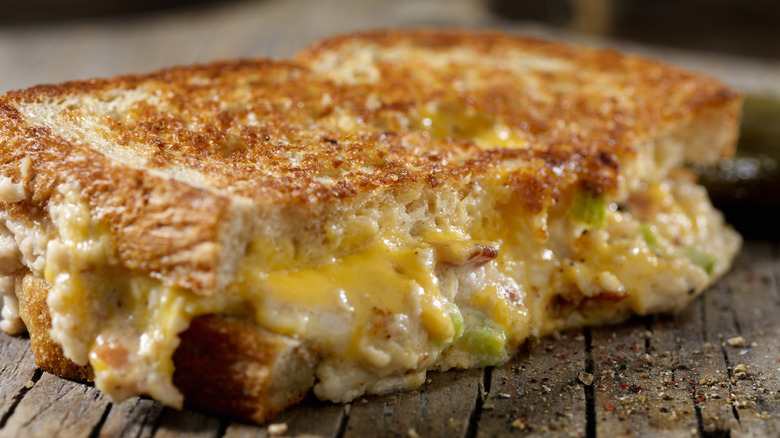13 Big Mistakes Everyone Makes When Cooking A Grilled Cheese Sandwich
There's nothing quite like a grilled cheese. This humble sandwich amps up the classic combination of bread and cheese that's been keeping diners happy since Roman times, and the added touch of melting the cheese in between the bread and crisping up the slices has its roots in the French croque monsieur, a hearty meal that's still eaten to this day.
In the United States, the grilled cheese gained a lot of popularity during the Great Depression as a filling yet cheap dish. As tastes and food culture evolved throughout the 20th century, grilled cheeses became ever more sophisticated and fancy, with the world's most expensive grilled cheese coming in at well over $200 and being made with truffle oil, lobster, and champagne.
At its core, a grilled cheese sandwich is basic. All you require is a few slices of bread, some cheese, and a pan to cook it in. So why does this simple sandwich often go so wrong? Grilled cheeses are notoriously prone to becoming burnt on the outside and not melted enough in the middle. They can also end up pretty lacking in crunch, an essential textural component for the sandwich. These can all occur from completely avoidable mistakes, which we will put a stop to immediately.
1. Using the wrong type of bread
Making the right choice with your bread is completely vital to the success of a grilled cheese. Your bread should have a large surface area and be thin enough for the heat to be able to permeate through to melt the cheese inside, but not too thin that it disintegrates. The slices you go for should also be able to crisp up easily but not have too dense or brittle of a crust, which can sometimes make your sandwich difficult to bite through — and it should also be a shape that's easy to handle, and which fits in your pan well.
Opting for fancier breads, like slices of crunchy baguette or soft, delicate brioche, will likely ruin your sandwich. Instead, when making grilled cheeses, it's good to go simple. A classic sandwich loaf will usually do the trick, or you can opt for a multigrain loaf for some added nuttiness and crunch.
If you want a little more complexity, using some slices of sourdough can be a great choice, with the added sponginess and density of the bread giving your sandwich added structural robustness. For a more unexpected bread choice, try making a grilled cheese with Indian naan bread or a dark pumpernickel loaf, with the latter providing an earthy flavor and a chewy texture.
2. Slicing your cheese too thickly
In our opinion, a grilled cheese is always better when it has more cheese inside. How you slice that cheese, however, is something you need to think about. All too often, people fill their grilled cheeses with thick, chunky slices, which are then too dense to melt through entirely. As a result, you can end up with a grilled cheese that's either half-full of solid cheese or overcooked on the outside.
There are two solutions to this issue, and both of them are refreshingly simple. Either slice your cheese more thinly or fill your sandwich with grated cheese instead. Grated cheese will generally melt way quicker than slices, but bear in mind that it can be harder to handle sometimes, and you run the risk of it leaking out of your sandwich and burning in your pan.
Grated cheese can often end up slightly uneven in your sandwich, too, which gives you ungainly lumps of dairy to chew through. Conversely, sliced cheese holds its shape and is far more predictable. Still, you may end up with a less densely packed sandwich than you'd like.
3. Using a cheese that doesn't melt properly
Biting into a grilled cheese and finding that the cheese inside hasn't melted is a sheer tragedy, and this can easily happen if you're using non-melting cheese. Some cheeses, like blue cheese, goat cheese, halloumi, or feta, tend to soften instead of melt. This means that they don't have the same chewiness and stretchability that other types will, and while they'll still be delicious, they will lack that quintessential grilled cheese texture.
The best cheeses for grilled cheese sandwiches marry punchy taste with an oozing, unctuous texture that produces an excellent cheese pull. Swiss and Monterey Jack are classic choices for grilled cheese, with both of them having a creamy, slightly nutty flavor that marries well with other tastes.
Monterey Jack is a particularly good choice in a grilled cheese that includes sharper or spicier flavors. Cheddar cheese is also ideal for grilled cheese, as not only does it melt and stretch well, but it has a flavor that can range from mild to incredibly sharp. As such, it gives your sandwich a customizability that other types of cheese may not offer.
4. Forgetting to butter the outside of your bread
A grilled cheese is nothing without a crispy, browned exterior, achieved by cooking it in a hot pan. However, if you fail to put fat on the outside of your bread, you'll have problems. If you place your bread in the pan dry, it'll simply burn instead of brown, giving it a charred taste and also drying out your bread slices.
While you can use pretty much any fat on the outside of your bread, our top choice is butter. Butter gives your bread a luxurious, creamy taste that pairs perfectly with the mellowness of the cheese inside. Additionally, grilled cheeses lend themselves to a longer, slower cooking process, meaning that you can safely use butter without it reaching its smoke point and starting to burn.
Adding butter to the outside of the bread instead of melting it in the pan gives you better coverage overall in your slices. It also prevents one side of the sandwich from soaking up all of the fat when you place it in your skillet.
If you're not a fan of butter or don't have any in the fridge, try using mayo instead. Full-fat mayo has a tanginess to it that helps to balance out the cheese flavors inside, and its fat content gives the bread just as good of a crisp as butter does.
5. Not mixing up your cheeses
If you're only using one type of cheese in your grilled sandwich, you're going about things the wrong way. There's nothing inherently incorrect about only using one type of cheese, but when you do so, you miss out on exciting flavor combinations that elevate the sandwich from being one-note. For example, using a blend of mild and spicy cheeses can provide a grilled cheese with a more rounded flavor.
Different cheeses also have different melting styles; combining them can give you a slightly more balanced texture than using only one. Throwing in a few different cheeses can also vary your sandwich from bite to bite, which will keep your meal dynamic and delicious.
For an elite combination, try combining a mellow smoked Gouda, a buttery Gruyére, and a sharp cheddar. Using a few cubes of brie amongst more subtle cheeses like Colby or Swiss will give your sandwich a funkiness that other dairy products can't emulate. If you know that the cheese you're using doesn't melt as effectively as you'd like, mix in some grated mozzarella, which will make everything more pliable, or use some slices of American cheese.
6. Using bread that's not toasted
One of the main issues with grilled cheese sandwiches is an unevenness of texture. The joy of the sandwich lies in its balance of soft, stretchy, melted cheese and crispy, crunchy bread. However, depending on the type of bread you choose, that crispiness can often be inadequate, and the combination of the fat and moisture content in the cheese can soften the loaf from the inside, making everything too chewy.
You can counteract this by toasting your bread before you construct your sandwich. Doing this gives your bread extra firmness on both sides and prevents it from softening too much from any moisture. Toasting your bread beforehand can also give it extra flavor, as you'll generate brownness on both sides instead of just one side.
Remember that by toasting your bread before making your grilled cheese, you're partially cooking it. That means that when you come to frying it, it may burn quicker. Therefore, try only to lightly toast the bread to firm it up while minimizing the chances of it charring. You can also toast the bread on one side and use the toasted side on the inner part of the sandwich.
7. Turning your heat up too high
A grilled cheese is a quick and easy meal, but one aspect of it might take longer than you think — the actual cooking process. There can be a tendency to crank up the heat high when cooking grilled cheeses to try and get the whole thing done in just a few minutes. When you do this, you don't give the heat enough time to permeate into the middle of the sandwich. This leaves the inside cold and the cheese unmelted while the outside burns.
Rather than do this and ruin your grilled cheese, keep the heat down and extend your cooking time. It's best to operate with a medium-low temperature, which will be sufficient to generate crispiness on the outside of the sandwich while preventing it from burning.
You'll want to cook the grilled cheese for as long as it takes to fully melt the dairy in the middle, and at this temperature, this can take around 15 to 20 minutes, flipping the sandwich halfway through. To check whether it's fully melted through, gently prise the slices apart from each other.
8. Only putting cheese inside the bread
Even people who have never had a grilled cheese sandwich know that the cheese goes in the middle. That's not the only place it can go, though. By using melted Parmesan, you can create a crust on the outside of your sandwich that creates the same crispiness that frying it in butter would.
To achieve this, warm up a greased pan on your stove, and then sprinkle some grated Parmesan into the skillet before placing your bread slices on top of them. Once the cheese has melted slightly, place your filling cheese on top of your slices before placing the two pieces of bread together. Proceed to fry your grilled cheese as you normally would on medium-low heat. As it cooks, the Parmesan-studded sides will become flecked with crispy, deeply savory pieces while the inside melts as normal.
We can understand that this method might be a little messy to execute, though. So, to cut down on cheese pieces everywhere, try constructing your sandwich as normal and then patting grated Parmesan directly onto its outside. Remember to butter both pieces of the bread before doing so to ensure it sticks properly. If you don't have any Parmesan, you can use any other cheese that's similar.
9. Using a pan that's not nonstick
When making a grilled cheese, you need to keep things mobile — but that won't happen if you're not using a nonstick pan. If you use a pan that's not nonstick, you increase the likelihood that your grilled cheese will catch on its surface as it's cooking. Although you can minimize the chances of this happening by using ample amounts of butter or another fat on the outside of the sandwich or avoiding prodding or moving it before it browns sufficiently, it can still occur.
When it does, the chances of the bread ripping as you try to move it are higher, and this may completely ruin your grilled cheese. As such, you should always use a nonstick pan. Remember that this doesn't have to be a pan coated with Teflon or some other nonstick material. It could also be a pan that's been seasoned to generate a natural nonstick coating.
You'll also want to make sure your pan is big enough to fit your bread inside comfortably. Importantly, you should avoid using a pan with high sides. This will cause any steam or moisture that's released from the sandwich to collect, and it will also make flipping your sandwich more challenging.
10. Forgetting to add some pressure
The melt in a grilled cheese relies on consistent heat spreading through the sandwich. So, if you have any gaps of air, or the whole thing is loose, that can inhibit things. You'll also need to make sure your sandwich remains compact throughout — and that's where pressure comes in.
Pushing down on the top of your sandwich as it cooks helps the heat get through it properly and, additionally, creates more contact between the bread and the pan. This not only ensures that the bread conducts more heat but also generates a more even golden crust.
To create pressure, you can use your spatula. Press down on the sandwich periodically, laying the spatula across the bread evenly to apply consistent pressure. You can also use a panini press to leave on top of the sandwich to make it thinner, intensifying each bite. It's best, however, to avoid using a pan lid or the bottom of another pot, advises Montclair Golf Club chef Ken Stelmack via Golf Magazine. These objects may not be cleaned as rigorously as your other kitchen utensils and, therefore, may harbor dirt or bacteria.
11. Leaving your lid off the pan
Generating all-around heat can be a great way to ensure that your cheese melts properly in a grilled cheese sandwich. However, this can be hard to achieve with a frying pan. Because these pans are shallow, the heat tends to lift away from them pretty quickly. As a result, you can be left constantly flipping your grilled cheese to try and keep heat moving through it.
By using your pan's lid, you can trap the heat around your grilled cheese effectively. Simply place your lid on a few minutes into the cooking process once your bread has started to crisp up slightly and the pan has generated sufficient warmth.
It's important not to leave your lid on for too long, as this can result in a build-up of moisture and steam around the grilled cheese, which will permeate into the bread and make it soggy. Avoid this by using your lid for just a few minutes. Then, once the heat has spread through your sandwich properly, lift it off and brown your grilled cheese as normal.
12. Forgetting to use your air fryer
Grilled cheeses are, by their very nature, slightly misnamed. These sandwiches are traditionally fried instead of grilled, after all. And so, in our opinion, there's no reason why you can't use other kitchen appliances, like air fryers, to make them.
An air fryer is an excellent choice for a grilled cheese sandwich due to the wrap-around heat that it produces. Because air fryers work via conduction technology, the hot air they create circulates around your sandwich, creating an even cook on every side without having to flip it and warm the cheese in the middle.
Air fryers are also great for making grilled cheeses, as larger models can fit several sandwiches side-by-side, drastically cutting down your cooking time if you're catering to a large crowd. For the best result from your air fryer, aim for a two-stage cooking process.
Begin on a lower setting to warm your sandwich through and melt the cheese. Then, crank up the heat for the last few minutes. By doing this, you'll prevent the outside of your sandwich from burning before the cheese inside has softened. Make sure you butter the outside of your sandwich, too, so that you get the same crispiness on the outer edge.
13. Not experimenting with your fillings
A simple grilled cheese, made with one type of cheese, some butter, and some white bread, is a delicious meal in its own right. But there are some delicious takes on grilled cheese out there, and one mistake that everyone makes is forgetting about them.
In some variations, the cheese works as a base for flavors that offer sharpness, spiciness, or additional creaminess, and you can also make a grilled cheese healthier by loading it up with vegetables. To make a grilled cheese heartier, simply add in some sliced ham, pre-cooked bacon, or shredded rotisserie chicken for a lighter boost of protein.
A pop of herbal flavor can be achieved by slathering some pesto on the inside of your sandwich and pairing it with mild gruyére to allow the Italian sauce to shine. Fans of gooey cheese may want to spread peanut butter on top of their cheese slices, finishing it off with a few dollops of bacon jam for a savory-sweet hit.
Meanwhile, placing some slices of red onion and tomato in your sandwich can add both crunch and a bright, vegetal flavor, as well as some additional nutrients. And finally, remember that with grilled cheeses, nothing's off the table.
